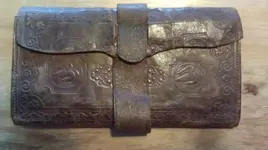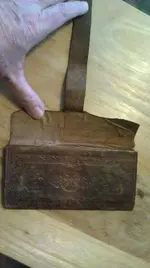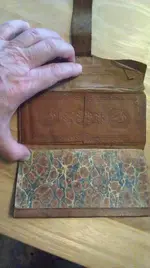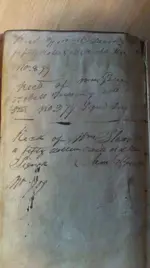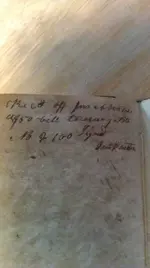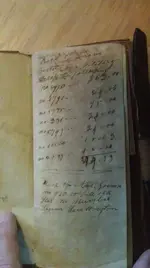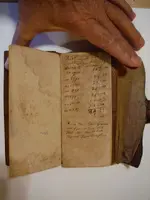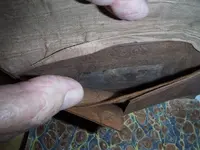Here is some more info about one of the names, WM. Slaughter found at this location.
Please excuse the length, but I have the text in
BOLD for the most relevant parts, but it is an interesting story throughout.
It appears the name mentioned in ledger, WM. Slaughter is the father, but it looks like his son had extensive contact with Sam Houston before and during the conflict.
http://files.usgwarchives.net/tx/freestone/bios/slaughter2.txt
Freestone County, Texas
Biographies
Biography of Rev. George Webb Slaughter
(May 10, 1811-Mar. 19, 1895, buried Palo Pinto Cemetery in Palo Pinto, TX.)
Source - Historical and Biographical Record of the Cattle Industry and the
Cattlemen of Texas. By James Cox. 1895. Published by Woodward & Tiernan
Printing Co. of St. Louis.
REV. G. W. SLAUGHTER.
THOUGH sixty years have passed since the occurrence of the stirring scenes
which ushered in the Lone Star Republic, there yet remains, scattered over the
plains and among the hills of this great State, quite a number of the daring
spirits whose bravery and fortitude interposed, like a granite wall, against
the destructive wave of Mexican oppression. Each year the sadly thinned ranks
of the veterans grow thinner still under the relentless touch of death, but
those who remain are honored with the love and respectof their fellow-citizens
as worthy representatives of the true aristocracy of Texas. Surviving the
danger of Santa Anna's lead and steel, and the vicissitudes and hardships of
the years following a successful revolution, they have labored as earnestly in
erecting the superstucture of the new government as in cementing the foundation
stones in the stormy days of '36, and their efforts have won due recognition
and, that best of all rewards, public approval.
The name which appears at the head of this page is well known in every
neighborhood from the Sabine to the Rio Grande, and its possessor may be
accepted as a true type of the class referred to above. He has lived in Texas
under the three forms of government which it has known in the present century,
and as a citizen of a Mexican State, an independent republic, or a part of the
American Union, his life has been an active one and above reproach.
George W. Slaughter is a native of LawMice County, Mississippi, his birth
occurring May 10, 181l.
William Slaughter, his father
, was a Virginian, born in 1781; his death occurring in Sabine
County, Texas, in 1851. The elder Mr. Slaughter was a fanner, and had seen
service in the war of 1812, fighting under Jackson at New Orleans. He married
Miss Nancy Moore, of 8outh Carolina, and was the father of eight children,
four of them boys. In 1821 the family moved to Copiah County, Mississippi, and
four years later started to Texas, but stopped for a time in Louisiana, and it
was while living in the latter State that «• W. Slaughter received the only
schooling—three weeks in all-which he ever had an opportunity to obtain. In
1830 the Slaughter family crossed the Sabine River and settled in what was then
the Mexican State of Coahuila. At that time the country east of Austin was
divided into municipalities governed
[graphic]
REV. G W. SLAUGHTER.
principally by military laws. Petty officers were in charge at the different
points, and alcaldes or magistrates were appointed by them, while all matters
of importance were referred to the District Commandant. Colonel Piedras was in
charge of the country along the Sabine, with headquarters at Nacogdoches, and
he was a man of narrow and decided views, but poorly qualified to wield
authority over a people reared in the enjoyment of American liberty. There was
no tolerance of religious belief beyond a blind adherence to the Catholic
Church, and the arrest by Colonel Piedras of several Protestant clergymen, who
had attempted to hold services in the colony, precipitated one of the first
conflicts between the colonists and the Mexican Government. G.W. Slaughter,
then a boy of nineteen or twenty, took an active part in the armed resistance
to this act of tyranny, and his relation of the events which followed is vivid
and interesting. A commissioner sent to Col. Piedras to intercede for the
prisoners' release was treated with contempt, and Col. Bean Andrews, who
repaired to the City of Mexico on the same errand, was thrown into prison at
once. Despairing of obtaining recognition and relief through pacific methods,
the colonists held a mass meeting at San Augustine about June 1, 1832, and
resolved to take matters in their own hands and release the prisoners, if
needs be, by force of arms. Preparations for this decisive step went quietly
on, and in a short time five hundred armed men assembled within two miles of
Nacogdoches, and sent to Col. Piedras, under a flag of truce, a demand for the
prisoners' liberation. In reply, a company of cavalry came forth with a
counter demand for the surrender of the entire party. Immediate hostilities
followed, the Mexicans were driven back to the town, after one or two
ineffectual stands, and eventually forced to evacuate the fort and seek safety
in flight. Quite a number of Mexicans were killed, but only three Americans,
one of whom was G. P. Smith, an uncle of G. W. Slaughter. At that time the
Angelina River was swollen with recent rains, its bottom lands flooded, and
impassible except at one point, some eighteen miles from the fort, where a
bridge had been built. Here, all the men who were provided with horses were
directed to hasten and stop the retreat of the panic-stricken Mexicans, while
the remainder of the force followed on, thus bringing the enemy between two
fires and compelling the entire command to surrender. After several weeks of
captivity, Col. Piedras was allowed to return to Mexico, under promise of
excusing the colonists' acts and interceding for their pardon, but he proved
false to his trust, and his report of the affair at Nacogdoches only incensed
the Government more than ever.
Mr. Slaughter was under fire for the first time in this skirmish or battle.
During the temporary lull which followed, previous to the general outbreak of
war, he was occupied in freighting between Louisiana and Texas points, and one
of his loads—perhaps the most valuable of them all—
consisted of the legal
library of Sam Houston, which he hauled to Nacogdoches in 1833. He had
previously met Houston while attending court at Natchitoches, Louisiana, and
he mentions the fact that, upon this occasion, the future President of the
Texan Republic was dressed in Indian garments, and decked out in all the glory
of scalp-lock feathers and silver ornaments. Mr. Slaughter was an earnest
admirer of Houston, and was more than pleased when the latter assumed control
of the Texan forces. The company in which he enlisted reported to Houston for
duty at San Antonio, and was in several of the engagements which immediately
followed, among others the famous "Grass Fight," one of the hottest of the
war. Houston then advanced toward Mexico, but halted near Goliad upon
intelligence that Santa Anna was approaching with an army of 15,000 men. Col.
Fannin, with the forces under his command, was encamped in a strong position
in a bend of the river below Goliad. Travis was in the Alamo with those gallant
spirits who were to remain with him, faithful and uncomplaining, until death.
Houston, safe in the consciousness that on the open prairie lay perfect safety
from beleaguerment, watched the approach of the Mexican army, and pleaded with
Fannin and Travis to abandon their fortifications and join him. Mr. Slaughter
served as a courier, making several trips to Fannin and to the Alamo, and while
making a hazardous trip to the latter place—then known to be invested by Santa
Anna's army—he encountered Mrs. Uickerson and her negro slave, the only
survivors of the massacre, who had been released by the Mexican Commandant and
instructed to proceed to General Houston with tidings of Travis' fate. The
butchery of Fannin and his men followed shortly after, and Santa Anna pressed
on after Houston, who had retreated to the east side of the Brazos. Meantime,
Mr. Slaughter was employed in carrying messages and in procuring subsistence
for the army, accepting many dangerous missions and performing them all to the
satisfaction of his commanding officer. History relates how Houston retreated,
and how the Mexican army followed until they were neatly led into the trap at
San Jacinto, where the tables were turned and Santa Anna captured, while his
army was swept out of existence.
The victory at San Jacinto was not the end of hostilities, but following it
there came a "breathing spell," of which Mr. Slaughter hastened to take
advantage. Gaining a leave of absence, under promise of returning at once in
case he was needed, he hastened to his home, and on the 12th day of the
[graphic]
MRS. G. W. SLAUGHTER.
following October was married to Miss Sarah Mason, to whom he had been for
some time engaged. The ceremony was only deferred to this date because, under
the disorganized state of the country, there was no officer with legal
authority to perform it. The marriage of Mr. Slaughter was the first ceremony
of the kind under the sanction of the republic which he had been instrumental
in establishing. The newly wedded couple settled in Sabine County, and Mr.
Slaughter resumed freighting for a livelihood, engaging in the employ of the
new Government. At the time of the Cherokee troubles, in 1839, the eastern
counties organized companies in pursuance to President Houston's order, and
Mr. Slaughter was elected Captain of the company organized in Sabine. The
newly recruited forces assembled at Nacogdoches, and, in a body, marched to
reinforce General Rusk, who was stationed with a small force on the Neches
River, near where Chief Bowles was encamped with 1,600 Cherokees. Two days
were spent in an ineffectual attempt to arrange a treaty, and then the Indians
dropped back from their position,
but were followed, and a fight ensued, in which the Cherokees lost eleven
killed, and the whites only three, though fourteen of their number were
wounded. The Indians again retreated, though very reluctantly, and the
following day there was a general battle; Chief Bowles was killed, with several
hundred of his followers, while the remainder of the Cherokees fled to the
westward, being followed to the Bois D'Arc fork of the Trinity, three or four
days' march, by the companies of Captains Slaughter and Todd.
The need which had prompted the organization of an armed force now existing no
longer, the men disbanded, and Mr. Slaughter returned to the labors and
attendant comforts of home life. In 1852 he moved to Freestone County,
intending to turn his attention principally to stock raising. He brought with
him ninety-two head of cattle, and established a ranch near the old town of
Butler, and in the five years that he resided at this place increased his herd
to 600 head. There were possibilities of a prosperous future in the cattle
business in Freestone County, but Mr. Slaughtfr believed that there were still
better opportunities to be gained by a removal to a point farther west, and in
1857 he drove his herds to Palo Pinto County, locating five miles north of the
town of that name, at that time known as Golconda. He bought here 2,000 acres
of land, and located, by certificate, 960 more, and the ranch located at that
time is still his home, though, as will be noticed elsewhere, his residence at
this point has not been continuous. In 1858-59 Mr. Slaughter was occupied in
raising stock and running a small farm, but the following year he moved his
stock to Young County, at a point near the Ross Indian Reservation. He had
then 1,200 head of cattle and a small bunch of horses, but lost forty head of
the latter through theft by the Indians, in 1860, and for these, and for other
property stolen, he has now claims against the Government aggregating $6,500.
Mr. Slaughter's holding of cattle had increased in 1867-68 to such extent that
he decided to sell the greater portion of them, and he accordingly disposed of
12.000 to James Loving and Charles Rivers at a uniform price of $6. Rivers was
afterward killed by the Indians while in camp in Jack County. This killing
occurred in June, 1871. Following the sale of his cattle, Mr. Slaughter formed
a partnership with his son, C. C. Slaughter, whose biography appears elsewhere
in this book, and began driving cattle through to Kansas. The first drove only
consisted of 800 head, but they brought the neat little sum of $32,000, a
sufficient guarantee of the profit that might accrue from the business of
cattle dealing if carried on with judgment and on a large scale. For the seven
years following, up to and including 1875, the herds of Slaughter & Son were
driven from Texas to Kansas points, and from thence shipped to St. Louis and
Chicago. The drive in 1870 was probably the largest, numbering 3,000 head, and
the returns from this herd footed up $105,000.
In 1870 Mr. Slaughter moved his family to Emporia, Kansas, that his children
might have the advantage of the superior educational facilities at that point,
but in 1875 he returned to Texas, and resumed operations on his old ranch in
Palo Pinto County. The number of cattle handled and the money received from
their sale in the years that he spent on the trail can be expressed in round
figures, as follows: 1868 , 800 head, $32,000; 1869 , 2,000 head, $90,000;
1870, 3,000 head, $105,000; 1871, 2.000 head, $66,000; 1873 , 2,000 head,
$66,000; 1874, 2,000 head, $60,000; 1875, 1,000 head, $45,000. Such figures as
these go a long way toward impressing the reader with the importance of the
cattle business twenty years ago. The industry was then, practically, in its
infancy, but it proved an infant of rapid growth.
In 1876 Mr. Slaughter dissolved partnership with his son, C. C, taking into
business with him another son, Peter; and in 1878 they sold and shipped 4,000
cattle. Six years later, on account of declining health, Mr. Slaughter disposed
of his cattle interests, and has since devoted his time to the care of his
farm and other property. He has, at his Palo Pinto ranch, 1,280 acres of land
and owns 1,300 acres in other portions of the State, besides town property in
Mineral Wells. Securing his land when nearly the entire country was open for
his selection, Mr. 8laughter has one of the most desirable locations in the
county, and prizes it the more highly in remembrance of the hardships and
dangers attendant upon its settlement. During the first few years of his
residence in Palo Pinto County the Indians were very troublesome, and Mr.
Slaughter can relate many incidents of border warfare from the standpoint of
an eye-witness and participant.
In 1861 he had a skirmish with seven Indians on Cedar Creek, in Palo Pinto,
several shots were exchanged, but the Indians were finally frightened away.
Three years later, the Indians made a raid on the ranch and stole all of the
horses, and John Slaughter, a son, received a bullet wound in the breast.
Skirmishes with redskins were then of too common occurrence to attract much
notice beyond the immediate neighborhood. The entire Texan border was a
battlefield, and those who lived on the upper Brazos had to guard themselves
as best they might. In 1866 Mr. Slaughter was driving a small bunch of cattle
on Dry Creek, near Graham, when he was attacked by thirteen Indians, but his
carbine and revolver proved too much for their courage, and they
retreated after he had wounded one of their number. In the month of April,
1869, a band of Indians surrounded and massacred thirteen Government teamsters
near Flat Top Mountain, in Young County. Mr. Slaughter was within two miles of
this place, camped, with fourteen men holding 500 head of cattle which he had
gathered. The Indians attacked them, and they only escaped through strategy.
Six of the men were sent with the cattle in the direction of Sand Creek and
the remainder of them, including Mr. Slaughter and his son, C. C., made a
breastwork of his horses and awaited an attack. Profiting by a deep ravine at
hand, some of the men crept cautiously away, and suddenly appearing at another
point, made a charge upon the Indians, who supposed that reinforcements were
coming, and accordingly beat a retreat.
Mr. Slaughter has been an earnest worker all his life, and few men have proved
themselves so useful in as many and varied capacities. He is, and has been for
many years, a minister of the Baptist Church. During his ministry he has
baptized over 3,000 persons, and has helped to organize more churches and
ordain more preachers than any other person in the State of Texas. When Rev.
Mr. Slaughter first came to Palo Pinto County, in starting out to fill his
appointments as minister, he would saddle his horse, fill his saddle bags with
provisions, take along his picket rope, and arm himself with two six-shooters
and his trusty carbine. The distance between the places where he preached
being sometimes as great as sixty miles, it was often necessary for him to
camp over at night by himself. Twice he was attacked by Indians, but escaped
uninjured. On one occasion, while he was preaching in the village of Palo
Pinto, the county was so filled with hostile Indians and wrought up to such a
pitch that Mr. Slaughter kept his six-shooter and his carbine at his side
during the sermon, and every member of his congregation was likewise armed.
He never permitted business or fear of the Indians to interfere with his
pastoral work, and always made it a point to keep his engagements. He first
united with the Methodist Church in 1831, but in 1842 joined the Baptist
Church, and was ordained to preach in 1844. He has studied and practiced
medicine, and was, for a number of years, the only physician in Palo Pinto
County. It would be impossible to overrate his usefulness during those long
years, when the citizens of the northwestern counties were practically
isolated from the world and dependent upon each other for comfort and aid in
times of extremity and need. Ever thoughtful and kind, Mr. Slaughter has given
freely of his time and money in behalf of the poor of his community, and has
shared as liberally in the respect and love of all who know him, personally or
through report.
Eleven children were born to Mr. and Mrs. Slaughter; six boys and five girls.
Seven of them are still living, as follows: C. C., Peter E., J. B., W. B.,
Fannie, Sarah Jane and Millie.
Mrs. Slaughter died on the 6th of January, 1894. Her life had been a long and
eventful one, and she passed away from the scene of her earthly labors and
triumphs mourned and regretted by hundreds of earnest friends who had learned
to thoroughly appreciate her sterling worth and kindliness of heart.
Since the above sketch of Mr. Slaughter was prepared for this volume, this
good citizen and Christian gentleman has crossed the mystic river to that
bourn from whence no traveler returns, leaving many to mourn his loss and miss
him from the paths of usefulness and social life. He died at his home, six
miles north of Palo Pinto, Texas, at 11 P. m., March 19, 1895. His life was
an eventful one, and he died in the full triumphs of the Gospel that he loved
and preached for more than a half century.
